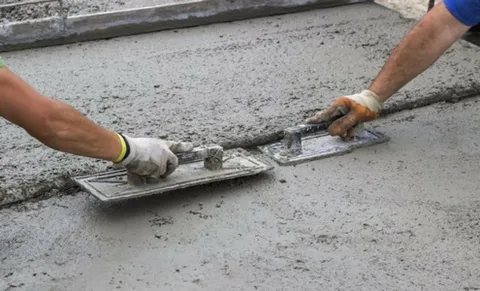Why Should You Seal Concrete?
Sealing concrete is essential to protect it from water damage, stains, UV rays, and wear and tear. Concrete is porous, meaning it absorbs liquids and is vulnerable to cracking, discoloration, and deterioration over time. A high-quality sealer acts as a protective barrier, significantly extending the lifespan of your concrete surfaces while maintaining their appearance and structural integrity.
What Are the Key Benefits of Sealing Concrete?
1. Protection Against Water Damage
Water is one of the biggest threats to concrete. When moisture seeps into the pores, it can cause cracks due to freeze-thaw cycles in cold climates or erosion in wet conditions. A concrete sealer repels water, preventing internal damage and prolonging the surface’s durability.
2. Resistance to Stains and Discoloration
Concrete surfaces in driveways, garages, and patios are prone to oil, grease, and chemical spills. Sealing creates a non-porous layer that prevents these substances from penetrating, making cleanup easier and keeping the concrete looking new for years.
3. Enhanced Durability and Longevity
Sealed concrete withstands heavy foot traffic, vehicle weight, and weather extremes better than unsealed concrete. Proper sealing can add 10+ years to your concrete’s lifespan by reducing cracks, spalling, and surface wear.
4. UV Protection to Prevent Fading
Sun exposure can cause concrete to fade and weaken over time. UV-resistant sealers (especially acrylic and epoxy types) shield the surface from sun damage, maintaining color and structural strength.
5. Improved Aesthetic Appeal
Sealers enhance the natural look of concrete, offering options like glossy, matte, or wet-look finishes. Whether for decorative stamped concrete or a simple driveway, sealing provides a polished, professional appearance.
What Types of Concrete Sealers Are Available?
1. Penetrating Sealers
Penetrating sealers (such as silane or siloxane) soak into the concrete and chemically bond with it, creating a water-repellent barrier without altering appearance. They’re ideal for outdoor use because they allow the concrete to breathe while preventing moisture damage.
2. Acrylic Sealers
Acrylic sealers form a thin protective film on the surface, offering UV resistance and a slight sheen. They are affordable and easy to apply but may require reapplication every 1-3 years.
3. Epoxy and Urethane Sealers
Epoxy and urethane sealers provide the strongest protection, making them ideal for high-traffic areas like industrial floors and garages. They create a thick, durable coating resistant to chemicals, abrasion, and heavy loads.
How Do You Choose the Right Sealer for Your Concrete?
1. Consider the Concrete’s Location and Use
- Driveways & sidewalks → Penetrating or acrylic sealers (weather-resistant).
- Garages & workshops → Epoxy or urethane (chemical and abrasion-resistant).
- Decorative concrete → Acrylic or glossy sealers (enhance appearance).
2. Assess Environmental Factors
- Cold climates → Penetrating sealers prevent freeze-thaw damage.
- Hot, sunny areas → UV-resistant acrylic or epoxy sealers.
- High-moisture zones → Waterproof penetrating sealers.
3. Match Sealer to Maintenance Expectations
- Low-maintenance option? → Penetrating sealers last longer with minimal upkeep.
- Willing to reapply every few years? → Acrylic sealers offer good protection at a lower cost.
- Need maximum durability? → Epoxy/urethane sealers provide long-term protection.
How Do You Properly Apply a Concrete Sealer?
1. Prepare the Surface
- Clean thoroughly: Remove dirt, oil, and debris with a pressure washer or degreaser.
- Repair cracks: Fill gaps with a concrete crack filler before sealing.
- Let it dry: Concrete must be completely dry (usually 24-48 hours).
2. Apply the Sealer
- Spray method: Best for large areas (use a low-pressure sprayer for even coverage).
- Roller/brush method: Ideal for smaller sections or thicker sealers like epoxy.
- Work in sections: Apply in overlapping strokes to avoid streaks.
3. Allow Proper Drying Time
- First coat: Let dry for 12-24 hours.
- Second coat (if needed): Apply in the opposite direction for full coverage.
- Final cure: Wait 24-48 hours before heavy use.
How Do You Maintain Sealed Concrete?
- Regular cleaning: Sweep and wash with mild detergent to prevent buildup.
- Reapply sealer: Acrylic sealers may need reapplication every 1-3 years; penetrating sealers last 5+ years.
- Avoid harsh chemicals: Acidic or abrasive cleaners can degrade the sealer.
Conclusion: Is Sealing Concrete Worth It?
Absolutely. Sealing concrete is a cost-effective way to prevent damage, enhance durability, and maintain a pristine appearance. Whether for a driveway, patio, or industrial floor, the right sealer will protect your investment for years to come.
Final Tip:
For best results, choose a high-quality sealer like UNIQUE® Concrete Sealer, which offers UV protection, water resistance, and easy application. Proper preparation and maintenance will ensure long-lasting protection and keep your concrete looking like new.

